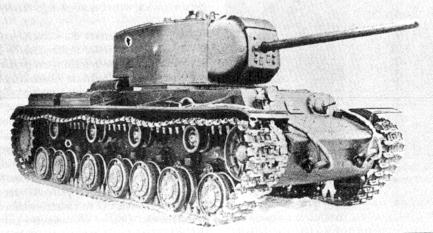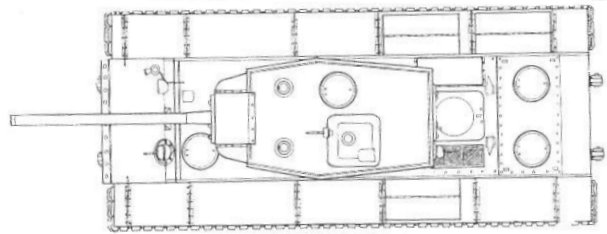This KW-2 was knocked out by artillerists of the General G�ring Division's 2nd Flak Regt. outside Dubno on June 29th 1941.
In the same time as the KW-1 was concieved it was decided to develop a close-support tanks housing a massive gun. The result was to be known as the KW-2 heavy artillery tanks which initially mounted a 122mm L/22 howitzer in an enlarged turret. They were later replaced by the massive turret housing the 152mm L/20 howitzer. The hull and chssis remained virtually unchanged. The huge box-like turret gave the vehicle a total height of 3.28m, which drew just too much enemy fire. The KW-2 performed well in the Finnish Winter War were it was used in set-piece assaults on the Mannerheim Line in 1940, but against the Germans in 1941 it was a different story. The huge turret with its four-man crew was so bulky that quick traverse was impossible, especially on an incline. The turret could only traverse on level ground, as the heavy weight made traverse on slope ground impossible. The weight of 52 tons made the KW-2 painfully slow with a maximum speed of just 26 km/h in ideal terrain and conditions. Most of the KW-2's were lost during the first months of the fightings against the Germans. As the Germans advanced deeper and deeper into Russia, many factories were moved to the Urals, but some could not be saved, and the production of the KW-2 died with those factories. At least one KW-2 was fitted with a BA-10 turret in the rear as extra armament. A total of 334 KW-2's were manufactured.
Some reports on German attacks on KW-2 tanks:
"Our companies opened fire from 700 meters. We got closer and closer, but it didn't disturb the enemy. Soon we were only about 50-100 meters from each other. A fantastic engagegment opened up - without any German progress. The Soviet tanks continued their advance and our armor-piercing projectiles simply bounced off. The Soviet tanks withstood point-blank range fire from both our 50mm and 75mm guns. A KW-2 was hit more than 70 times, and not a single round penetrated. A very few of the Soviet tanks were immobilized and eventually also destroyed as we managed to shoot at their tracks, and then eventually bringed up the artillery to hammer them at close range. Sturmpioniere then attacked by foot with satchel charges."
- A courir in the 1st Panzer Division of the 4th Panzergruppe, Raseiniai (Lithuania), June 23rd 1941.
"On July 3rd, we were attacked by T-34 and KW-2 heavy tanks on the main road between Minsk and Moscow near the river of Berezina. A KW-2 was hit 11 times, but none of the projectiles penetrated. During the next few days, our tanks won a series of engagements, however only because of the skill and tactics used. Soldiers of our 101'st Regt. demonstrated its ability to take on a tank in an engagement with one of the KW-2 gigants on July 7th. They attached several hand grenades to eachother and throwed it at the turret. When they had disabled the turret, a leutnant jumped up on the tank and a second soldier throwed a stick grenade to him. He catched it, armed it and then throwed it inside the KW-2's 152mm gun barrel and jumped away. The grenade detonated inside and made the 152mm shell loaded at the back in the breech to explode, which resulted in that the top hatch on the turret was blown off. A soldier then finished the tank by throwing in a satchel charge from 8 meters range."
- Commander of 18th Panzer Division - Walther Nehring, July 1941.

In late 1940/41 two prototypes were built, armed with a 85mm F-30 gun and three 7,62mm DT machine guns. Ammo load was 91 x 85mm rounds and 4.032 rounds for the MGs. It was equipped with a V-12 engine, providing 850 hp. It had a total weight of 63.000kg and its maximum speed was 33km/h.

Russian fanaticism?
July - August 1941
West om Uman, along the southern Bug river the Soviets counterattacked in a violent attempt to break the bridgeheads established east of Bug by the German 49th Gebirgsjaeger Korps.
"The Soviet infantry came in trucks, and tried to force us down with their mere mass of soldiers. They attacked in wave after wave with lorries in which the soldiers stood up and fired constantly. Then German recon units requested back-up from assault guns - StuG III Ausf. A-F - with a 75mm low velocity gun. I saw an assault gun which stopped to destroy the leading vehicles of an attack. It destoyed 18 Soviet trucks with soldiers in less than 3 minutes."
The attack got even stronger on the 2nd of August, when the first German infantry arrived by foor to link up with the tanks southeast of Uman. The pocket with the encircled Russians were now stronger, even though it had its weaknesses by a lack of German men and equipment. When the German tried to reinforce the ring around the pocket, the Soviets counterattacked with infantry and cossack units over and over again in an attempt to relieve themselves. German patrols took the risk to eliminate the pocket. Mines and camoflauged graves with sharp poles awaiting them. Soviet snipers had tied themselves up in trees to free their hands so they could point and shoot freely. Whole Soviet units hid themselves in the tight fog. During the whole first week of August, German mountain troops along the whole southern part of the ring to stop the Soviet stormattacks. The Russians in the ring throwed in everything they had in a last attempt to break out: infantry by foot, then cavalry and finally tanks followed by trucks carrying more infantry. The German mountain troops suffered heavily - 5.000 men killed or missing in action. During the Russian counterattacks, 4 guns of the 9th Battery in the 94th Mountain Artillery Regt. were cut off from its supporting infantry. The battery fought in self defence - sometimes with direct fire - and repeatedly halted the Soviet attacks. During the time of their lack of infantry support, the artillerymen of the battery knocked out 1 tank, 16 guns and 110 lorries. On 4 days they had fired 1.150 rounds, more than they had fired in the entire French campaign of 1940! The area around Uman were strewed with fallen soldiers; by a Germans oldier described as "an enormous graveyard". Another German soldier remembered the burnt out Russian trucks "In some, there were rows with sitting soldiers, burnt to ashes. The drivers remained in their seats, and the awful smell of burnt flesh smelled even worse than burning tires".